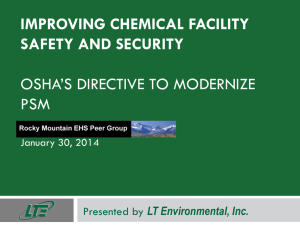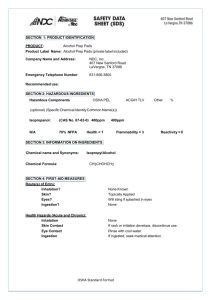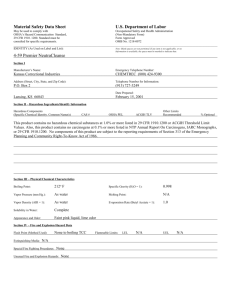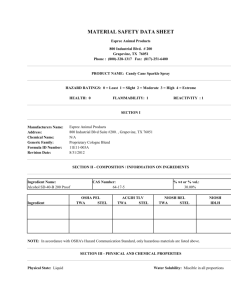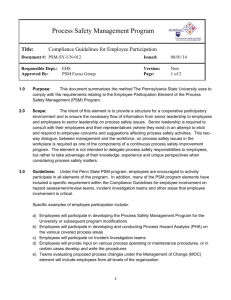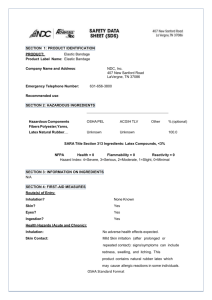PowerPoint 簡報
advertisement
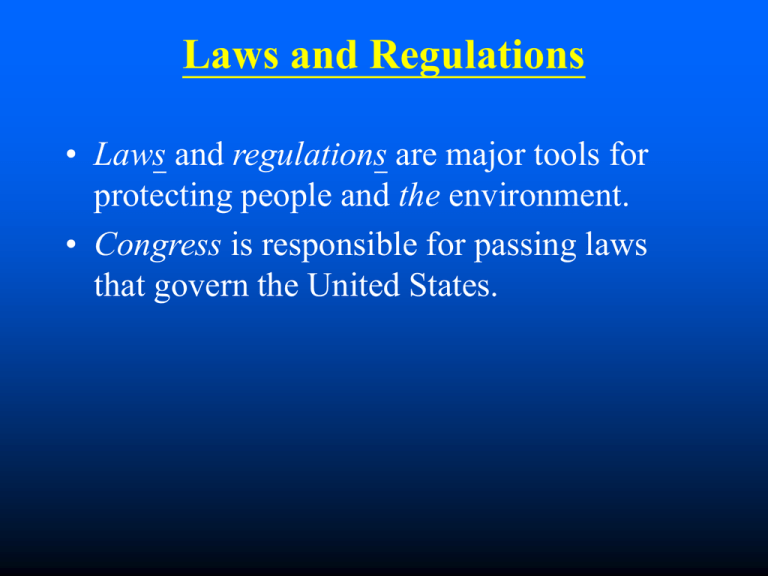
Laws and Regulations • Laws and regulations are major tools for protecting people and the environment. • Congress is responsible for passing laws that govern the United States. Creating a Law in US A law is created with a three-step process: Step 1: A member of Congress proposes a bill. A bill is a document that, if approved, become a law. Step 2: If both houses of Congress approve the bill, it is sent to the president, who has the option to either approve it or veto it. If approved, it becomes a law that is called an act. Step 3: The complete text of the law is published in the United States Code (USC). The code is the official record of all federal laws. Creating a Regulation or Standard To make the laws work on a day-to-day level, Congress authorizes governmental organizations, including the EPA and OSHA, to create regulations and/or standards. After the regulation is in effect, the EPA or OSHA has the responsibility (1) to help citizens comply with the law and (2) to enforce the regulation. Regulation/Standard Creating Procedure The process for creating a regulation and/or standard has two steps: Step 1: The authorized organization or agency decides when a regulation is needed. The organization then researches, develops, and proposes a regulation. The proposal is listed in the Federal Register (FR) so that the public can evaluate it and send comments to the organization. These comments are used to revise the regulation. Step 2: After a regulation is rewritten, it is posted in the Federal Register as a final rule, and it is simultaneously codified by publishing it in the Code of Federal Regulations (CFR). History • Before 1936 regulations concerning occupational health were poorly administered by state and local governmental agencies. During this era, staffs and funds were to small to carry out effective programs. • In 1936 the federal government enacted the Walsh-Healy Act to establish federal safety and health standards for activities relating to federal contracts. • The concepts promulgated by the Walsh-Healy Act, although not adequate by today’s standards, were the forerunners of our current occupational health and safety regulations. • Between 1936 and 1970 a number of states enacted their own safety and health regulations. • The OSHAct of 1970 was developed to solve these problems and to give a nationally consistent program with the funding necessary to manage it effectively. OSHA and NIOSH • As a result of the OSHAct, sufficient funding was committed to create and support the Occupational Safety and Health Administration (OSHA), which manages and administers the government’s responsibilities specified in the OSHAct, and the National Institute for Occupational Safety and Health (NIOSH), which conducts research and technical assistance programs for improving the protection and maintenance of workers’ health. • Examples of NIOSH responsibilities include (1) measuring health effects of exposure in the work environment, (2) developing criteria for handling toxic materials, (3) establishing safe levels of exposure, and (4) training professionals for administering the programs of the act. • NIOSH develops data and information regarding hazards, and OSHA uses these data to promulgate standards. • Some laws and regulations particularly relevant to the chemical industry are shown in Table 3-1. • As illustrated in this table, the distinction between laws (USC) and regulations (CFR) is global versus detail. Table 3-1 A Few Laws (USC) and Regulations (CFR) Number Description 29 USC 651 42 USC 7401 33 USC 1251 42 USC 7401 15 USC 2601 42 USC 300f 40 CFR 280.20 40 CFR 370.30 29 CFR 1910.120 29 CFR 1910.1450 40 CFR 370.20 29 CFR 1910.119 40 CFR 68.65 29 CFR 1910.134 Occupational Safety and Health Act (1970) Clean Air Act (1970) Clean Water Act (1977) Clean Air Act Amendments (1990) Toxic Substances Control Act II (1992) Safe Drinking Water Act Amendment (1996) Underground Storage Tank Leak Tests (1988) Annual Toxic Release Report, SARA 313 (1989) Training, Hazardous Materials Technician, HAZMAT (1989) Exposure to Hazardous Chemicals in Laboratories (1990) Annual Inventory of Hazardous Chemicals, SARA 311 (1991) Process Safety Management (1992) Rick Management Program (1996) Respirator Program (1998) • Highlight of OSHA enforcement rights are illustrated in Table 3-2. • Table 3-3 provides a summary of relevant safety legislation, and Figure 3-1 shows how the amount of legislation has increased. Table 3-2 Highlights of OSHA’S Right of Enforcement Employers must admit OSHA compliance officers into their plant sites for safety inspections with no advance notice. A search warrant may be required to show probable cause. OSHA’s right of inspection includes safety and health records. Criminal penalties can be invoked. OSHA officers finding conditions of imminent danger may request plant shutdowns. Table 3-3 Federal Legislation Relevant to Chemical Process Safety (1) Date Abbreviation Act 1899 1906 1947 1952 1952 RHA FDCA FIFRA DCA FWPCA River and Harbor Act Federal Food, Drug, and Cosmetic Act Federal Food, Drug, and Cosmetic Act Dangerous Cargo Act Federal Water Pollution Control Act 1953 1954 1956 1960 1965 1966 1969 1969 FFA AEA FWA FHSA SWDA MNMSA NEPA CMHSA Flammable Fabrics Act Atomic Energy Act Fish and Wildlife Act of 1956 Federal Hazardous Substances Labeling Act Solid Waste Disposal Act Metal and Non-Metallic Mine Safety Act National Environmental Policy Act Federal Coal Mine Health and Safety Act Table 3-3 Federal Legislation Relevant to Chemical Process Safety (2) Date Abbreviation 1970 1970 1970 1970 1970 1970 1972 1972 1972 1972 1972 1972 1972 1973 CAA PPPA WQI RSA RRA OSHA NCA FEPCA HMTA CPSA MPRSA CWA CZMA ESA Act Clean Air Act Poison Prevention Packaging Act of 1970 Water Quality Improvement Act of 1970 Federal Railroad Safety Act of 1970 Resource Recovery Act of 1970 Occupational Safety and Health Act Noise Control Act of 1972 Federal Environmental Pollution Control Act Hazardous Materials Transportation Act Consumer Product Safety Act Marine Protection, Research, and Sanctuary Act of 1972 Clean Water Act Coastal Zone Management Act Endangered Species Act of 1973 Table 3-3 Federal Legislation Relevant to Chemical Process Safety (3) Date Abbreviation Act 1974 1974 1974 1976 1976 SDWA TSA ESECA TSCA RCRA Safe Drinking Water Act Transportation Safety Act of 1974 Energy Supply and Environmental Coordination Act Toxic Substances Control Act Resource Conservation and Recovery Act 1977 1977 1978 1978 1980 FMSHA SMCRA UMTCA PTSA CERCLA 1984 1986 HSWA AHERA Federal Mine Safety and Health Act Surface Mine Control and Reclamation Act Uranium Mill Tailings Control Act Port and Tanker Safety Act Comprehensive Environmental Response, Compensation, and Liability Act of 1980 (Superfund) Hazardous and Solid Waste amendments Asbestos Hazard Emergency Response Act Table 3-3 Federal Legislation Relevant to Chemical Process Safety (4) Date Abbreviation 1986 1986 1986 1987 1990 SARA EPCRA TSCA WQA OPA Superfund Amendments and Reauthorization Act Emergency Planning and Community Right-to-Know Act Toxic Substances Control Act Water Quality Act Oil Pollution Act of 1990 1990 1990 1992 1992 1993 1994 1996 1996 CAAA PPA TSCA-II -NEPA HMTAA SDWA FQOA Clean Air Act Amendments Pollution Prevention Ac of 1990 Residential Lead-Based Paint Hazard Abatement Act Federal Facility Compliance Act National Environmental Policy Act Hazardous Materials Transportation Act Amendments Safe Drinking Water Act Amendment Food Quality Protection Act Act Figure 3-1 Number of federal laws relevant to chemical process safety. OSHA: Process Safety Management On February 24, 1992, OSHA published the final rule “Process Safety Management of Highly Hazardous Chemicals”. (PSM) Process safety management (PSM) was developed after the Bhopal accident (1985), to prevent similar accidents. The standard is performance oriented, that is, it sets general requirements for management of hazardous chemicals. The PSM standard has 14 major sections: (1) employee participation, (2) process safety information, (3) process hazard analysis, (4) operating procedures, (5) training, (6) contractors, (7) pre-startup safety review, (8) mechanical integrity, (9) hot work permits, (10) management of change, (11) incident investigations, (12) emergency planning and response, (13) audits, and (14) trade secrets. (1) Employee participation requires active employee participation in all the major elements of PSM. Employers must develop and document a plan of action to specify this participation. (2) Process safety information is compiled and made available to all employees to facilitate the understanding and identification of hazards. This information includes block flow diagrams (BFD) or process flow diagrams (PFD), process chemistry, and process limitations, such as temperatures, pressures, flows, and compositions. Consequences of process deviations are also required. This process safety information is needed before training, process hazards analysis, management of change (MOC), and accident investigations. (3) Process hazard analysis (PHA) must be performed by a team of experts, including engineers, chemists, operators, industrial hygienists, and other appropriate and experienced specialists. The PHA needs to include a method that fits the complexity of the process, a hazards and operability (HAZOP) study for a complex process, and for less complex processes a less rigorous process, such as what-if scenarios, checklists, failure modes and effects analysis, or fault trees. Every PSM process needs an updated PHA at least every five years after the initial analysis is completed. (4) Operating procedures that facilitate the safe operation of the plant must be documented. • They need to cover, at a minimum, initial startup, normal operations, temporary operations, emergency shutdown, emergency operations, normal shutdown, startup after normal and emergency shutdowns, operating limits and consequences of deviations, safety and health considerations, hazardous properties of the chemicals, exposure precautions, engineering and administrative controls, quality control specifications for all chemicals, special or unique hazards, and safety control systems and functions. • Safe work practices also need to be documented, such as hot work, lockout/tagout, and confined space. • These operating procedures are updated frequently, with the frequency being set by the operating personnel. (5) An effective training program helps employees understand the hazards associated with the tasks they perform. Maintenance an operation personnel receive initial training and refresher training. Operators need to understand the hazards associated with every task, including emergency shutdown, startup, and normal operation. Refresher training is given every three years and more often if necessary; the operators decide on the frequency of the refresher training. (6) Contractors are trained to perform their tasks safely to the same extent as employees. Even when selecting contractors, the employees need to consider the contractors’ safety performance in addition to their skills. (7) A pre-startup safety review is a special safety review that is conducted after a modification to the process or operating conditions has been made and before the startup. In this review a team of reviewers ensures that (1) the system is constructed in accordance with the design specifications, (2) the safety, maintenance, operating, and emergency procedures are in place, (3) the appropriate training is completed, and (4) the recommendations from the PHA are implemented or resolved. (8) The mechanical integrity section of the PSM standard ensures that the equipment, piping, relief system, controls, and alarms are mechanically sound and operational. The requirements include (1) written procedures to maintain functioning systems, (2) training regarding preventive maintenance, (3) periodic inspections and testing based on vendor recommendations, (4) a process to correct deficiencies, and (5) a process to ensure that all equipment and spare parts are suitable. (9) The PSM standard ascertains that a system is in place to prepare and issue hot work permits before conducting hot work activities (welding, grinding, or using spark-producing equipment). The permit requires dates authorized for hot work, the equipment involved in the work, a system to maintain and document certification, identification of openings where sparks may drop, the types and numbers of fire extinguishers, identification of fire watches, an inspection before the work, authorization signatures, identification of flammable materials in the area, verification that the surrounding area is not explosive, verification that combustible materials are removed or covered appropriately, identification and closure of open vessels or ducts, and verification that welded walls are not flammable. (10) Under the management of change section of the PSM standard employees are required to develop and implement documented procedures to manage changes in the process chemistry, process equipment, and operating procedures. Before a change occurs (except for replacement-in-kind), it must be reviewed to ascertain that it will not affect the safety of the operation. After the change has been made, all the affected employees are trained, and a pre-startup review is conducted. (11) The PSM standard mandates incident investigation. • Employers must investigate all incidents that have or could have resulted in a major release or accident within 48 hours of the event. • The regulation requires an investigation team composed of people, including operators, who are knowledgeable about the system. • After the investigation, the employers are required to appropriately use the investigation recommendations. (12) The intent of the PSM element for emergency planning and response is to require employers to respond effectively to the release of highly hazardous chemicals. Although the regulation requires this activity for companies with more than 10 employees, this element should be part of a program for even the smallest organizations that handle hazardous chemicals. (13) Under the audits section of the PSM standard employers are required to certify that they have evaluated their compliance with the standard at least every three years. The recommendations from the audit must be followed. The audit reports need to be retained as long as the process exists. (14) The trade secrets section of the PSM standard ensures that all contractors are given all the information relevant to operating in the plant safely. Some personnel may need to sign secrecy agreements before they receive this information. EPA: Risk Management Plan On June 20, 1996, the EPA published the Risk Management Plan (RMP) as a final rule. This regulation is also a response to the Bhopal accident. • It is recognized by industry and the government as an excellent regulation that will reduce the number and magnitude of accidents if it is understood and practiced as intended. • The RMP regulation is aimed at decreasing the number and magnitude of accidental releases of toxic and flammable substances. • Although the RMP is similar to the PSM regulation in many respects, the RMP is designed to protect off-site people and the environment, whereas PSM is designed to protect on-site people. • The RMP is required for plant sites that use more than a specified threshold quantity of regulated highly hazardous chemicals. • The RMP is a site responsibility (the site may have several processes), whereas PSM covers every covered process on the site. Elements of RMP • • • • hazard assessment, prevention program, emergency response program, documentation that is maintained on the site and submitted to federal, state, and local authorities. This information is also shared with the local community. The RMP document is updated when the process or chemistry changes or when a governmental audit requests an update. Hazard Assessment • Hazard assessment is a consequence analysis for a range of potential hazardous chemical releases, including the history of such releases at the facility. • The releases must include the worst-case scenario and the more likely but significant accident release scenarios. A risk matrix can be used to characterize the worst-case and more likely scenarios. EPA-Required Consequence Analyses 1. A single worst-case release scenario is analyzed for all covered flammable materials on the site, and only one flammable substance is analyzed for other more likely scenarios; 2. A single worst-case release scenario is analyzed for all toxic substances on the site, and more likely releases are analyzed for each toxic substance covered by the rule. • The worst-case scenario is based on releasing the entire contants of a vessel or piping system in a 10-minute period under worst-case meteorological conditions (F stability and 1.5 m/s wind speed). • Passive mitigation measures (for example, dikes) can be used in the calculation process; therefore the release rate for liquid spills corresponds to the evaporation rate. • Alternative release cases for toxic substances cover scenarios with toxic concentrations beyond the fence line. • Alternative cases for flammable substances cover scenarios that may cause substantial damage off site and on site. • The release scenarios that have a potential to reach the public are of the greatest concern. • Those with no off-site potential damage are not required to be reported. • Dispersion model calculations are normally used to estimate downwind concentrations; these concentrations are the basis for determining the consequences resulting from toxicity, fires, and/or explosions. • For those not interested in using dispersion models, the standard includes lookup table for all the listed substances to help a facility determine the impact distances for specific release scenarios. • The RMP requires only an analysis of the consequence and not the probability. Therefore the results are not a true determination of risk, because risk is composed of both consequence and probability. Prevention Program The second requirement of the RMP is a prevention program. The prevention program has 11 elements, compared to the 14 elements of the PSM standard. As shown is Table 3-4, many of these elements are duplicated. Fortunately, the EPA made a deliberate attempt to retain the same requirements wherever possible, although differences exist because the EPA and OSHA have different responsibilities. Table 3-4 Comparison of the PSM and RMP Prevention Programs (1) PSM program (OSHA) RMP (EPA) Process safety information Process hazards analysis Process safety information Hazard evaluation Operating procedures Standard operating procedures Employee participation (No equivalence) Training Training Contractors (No equivalence) Pre-startup review Mechanical integrity Pre-startup review Maintenance Table 3-4 Comparison of the PSM and RMP Prevention Programs (2) PSM program (OSHA) RMP (EPA) Hot work permit Management of change (No equivalence) Management of change Incident investigations Accident investigations Emergency planning and response Emergency response Compliance audits Safety audits Trade secrets (No equivalence) (No equivalence) Risk assessment Emergency Response Program • This program delineates the steps to be taken by the facility’s employees in response to accidental releases of hazardous materials. • It also establishes procedures for notifying the local community and the appropriate emergency response agencies. Training is for all employees on the topics relevant to emergency response. • The requirements include drills to test the plan and to evaluate its effectiveness, and the plan must be revised based on the findings of these drills. • The plan must be coordinated with local emergency response plans developed by Local Emergency Planning Committees (LEPCs) and local emergency response agencies. • As with similar OSHA regulations, the Resource Conservation and Recovery Act (RCRA), and the Spill Prevention Control under the Clean Water Act, the emergency response plan must be maintained at the facility and must include descriptions of all mitigating system.
